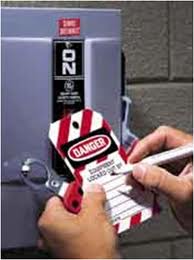
Our Lockout Tagout Training course teaches employees how to properly lock out and tag out equipment or machinery before performing maintenance or repair work. LOTO training aims to prevent the accidental start-up of equipment or release of stored energy, which can lead to serious injuries or fatalities.
Visit our Lockout Tagout Training Page
Our lockout tagout training allows students to access the live online training through our web-based platform from their own computer. You can see and hear the instructor and see his screen live. You can interact and ask questions. The cost of the training also includes seven days of email mentoring with the instructor.
Lockout Tagout training typically covers the following topics:
LOTO training is typically required by OSHA (Occupational Safety and Health Administration) and other regulatory agencies to ensure that employees are adequately trained to perform their jobs safely. Employers typically provide the training, which can be conducted in a classroom setting or online.
Purpose and benefits of LOTO procedures
The purpose of lockout tagout (LOTO) procedures is to prevent unexpected or unintended release of potentially hazardous energy that could cause serious injuries or fatalities to employees servicing or maintaining equipment or machinery. LOTO procedures provide a systematic way to ensure that all energy sources have been isolated and made safe before maintenance or servicing activities are performed.
Some of the key benefits of LOTO procedures include the following:
Improved safety: LOTO procedures help to protect employees from unexpected startup or energization of equipment or machinery, which can cause serious injuries or even death.
Compliance with regulations: Many countries have laws and regulations that require employers to implement LOTO procedures to protect their workers. Following these regulations can help employers avoid penalties and fines.
Reduction in accidents and injuries: By following LOTO procedures, employers can reduce the number of accidents and injuries that occur during maintenance or servicing activities.
Improved productivity: Employees who are adequately trained in LOTO procedures can work more efficiently and effectively during maintenance or servicing activities, improving overall productivity.
Cost savings: Implementing LOTO procedures can help employers avoid costs associated with accidents, injuries and downtime due to equipment failure.
In summary, LOTO procedures are an essential safety measure that can help to protect employees, ensure compliance with regulations, and improve productivity and cost savings.
Our LOTO Training Course teaches the types of energy sources that must be controlled.
Several energy sources must be controlled during lockout tagout (LOTO) procedures. These energy sources can include:
Electrical energy
Mechanical energy
Hydraulic energy
Pneumatic energy
Thermal energy
Chemical energy
Radiation energy
During LOTO procedures, all of these energy sources need to be identified and controlled to prevent unexpected or unintended release of energy that could cause serious injuries or fatalities to employees servicing or maintaining equipment or machinery.
Our training teaches the steps for locking out and tagging out equipment
The steps for locking out and tagging out equipment during maintenance or servicing activities are as follows:
Preparation
Notification
Shutdown
Isolation
Verification
Maintenance
Removal of Lockout/Tagout Devices
Verification of Equipment Function
Throughout the lockout/tagout procedure, the employee must communicate clearly with all affected employees and follow all safety procedures to prevent accidents or injuries. Also, proper training and supervision are essential for ensuring lockout/tagout procedures are performed safely and effectively.
We teach the different types of lockout and tagout devices
Our LOTO Training course examines the several types of lockout and tagout (LOTO) devices used to isolate energy sources and prevent accidental start-up of equipment or machinery during maintenance or servicing activities. Some common types of LOTO devices include:
Locks:
Lockout Hasps
Cable Lockout Devices
Ball Valve Lockout Devices
Tagout Devices
The type of LOTO device used will depend on the equipment or machinery being serviced and the energy source that must be isolated. Proper training and supervision are essential for ensuring that the correct LOTO devices are used and that they are used correctly to prevent accidents or injuries.
Our Lockout Tagout Training course teaches the responsibilities of employees and employers for LOTO procedures.
Lockout Tagout (LOTO) procedures are essential for the safety of employees working on or near machinery or equipment that could be dangerous if not properly secured. Both employees and employers have specific responsibilities for implementing and maintaining LOTO procedures. Here are some of the primary responsibilities of both:
Responsibilities of Employers:
Develop and maintain an energy control program that outlines the company's LOTO procedures.
Identify all equipment and machinery that requires LOTO procedures and ensure that employees are trained in these procedures.
Provide all necessary LOTO devices and equipment to employees, including locks, tags, hasps, and other tools.
Ensure that all employees are trained, understand the LOTO procedures, and have the appropriate knowledge and skills to perform their tasks safely.
Inspect and maintain all LOTO equipment, devices, and procedures regularly to ensure they are effective.
Conduct regular reviews of LOTO procedures to ensure that they are up to date and reflect any changes in equipment or operations.
Responsibilities of Employees:
Follow all LOTO procedures outlined by the employer and the energy control program.
Properly use all LOTO devices and equipment, including locks, tags, hasps, and other tools.
Notify their supervisor or designated person if they identify concerns or issues with the LOTO procedures or equipment.
Only perform work that they have been trained and authorized to do.
Follow all safety procedures and use appropriate personal protective equipment (PPE) when working on or near energized equipment.
Attend all LOTO training sessions provided by the employer.
Both employers and employees need to work together to ensure that LOTO procedures are implemented and maintained correctly. In addition, proper training, communication, and supervision are essential for keeping employees safe and preventing accidents or injuries.
Visit our Lockout Tagout Training Page